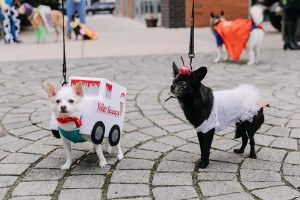8 Trends That Prove Philly Is Changing for the Better
5. The Public-Space Revolution
At 1.75 acres, Philadelphia’s new Sister Cities Park seems far too small to so perfectly represent some of the biggest new ideas in the use of public space. But does it ever.
On paper, it doesn’t sound like anything revolutionary: a pond for toddlers and their toy boats, a fountain, a cafe, and some rocks for nature-deprived city kids to clamber over. Put these things together, though, and design it all elegantly, and you have an utterly irresistible attraction that somehow manages to ever so slightly restore your faith in urban living. Seriously. Just try it. You’ll see schoolkids in uniform assembling armadas of red-sailed schooners; lawyers in suits taking alfresco lunch breaks; children shrieking in glee as they race across the fountain jets; delighted foodies foraging for blueberries. The panorama looks like a scene that’s been staged for a tourism brochure, and it’s like that all the time.
The park is the best proof yet of two relatively recent revelations that are changing the way urban planners think about public space. The first is that people flock to spaces that give them something to do. An open public plaza is nice, but if you stick a carousel and burger stand in it, à la Franklin Square, you’ve got a major attraction.
The second is that projects need not be huge or astronomically expensive to have a big impact on quality of life. On the extreme low end, West Philadelphia’s University City District has a few $10,000 mobile “parklets”—essentially some decking, railings and a few planters—that can be plopped onto the side of the street, providing an instant venue for outdoor socializing in exchange for a couple parking spots.
More ambitious is UCD’s work outside 30th Street Station, where the organization has partly beaten back the ugly asphalt jungle that greets train commuters with “The Porch,” a $400,000 collection of outdoor tables, plantings and new concrete, enlivened by an active programming schedule that includes a farmers’ market, yoga lessons and circus performances. It’s a relatively modest improvement, but that’s actually okay. UCD’s model is to make “small, iterative and experimental” investments in public space, instead of waiting for huge capital funds to appear out of the air.
At $5.2 million, Sister Cities represented a bigger gambit. But it’s still a relatively paltry sum by the standards of municipal capital spending. And the return on investment is staggering. “One of our core assumptions now is that quality public spaces attract and retain workers and residents,” says the Center City District’s Levy. (Surprise: CCD was behind the Sister Cities makeover as well.)
And Sister Cities is hardly the only fresh evidence that Levy is right. There’s the still-expanding Schuylkill Banks, and the Dock Street pier and its tantalizing preview of a remade Delaware Waterfront, and Hawthorne Park, built atop land where foreboding public-housing towers once stood. All have opened to rave reviews, and all have helped to awaken Philadelphians to the uncanny power of well-planned public space to improve quality of life. Reading Viaduct, anyone?
>> Last Rites for Truly Public Schools


